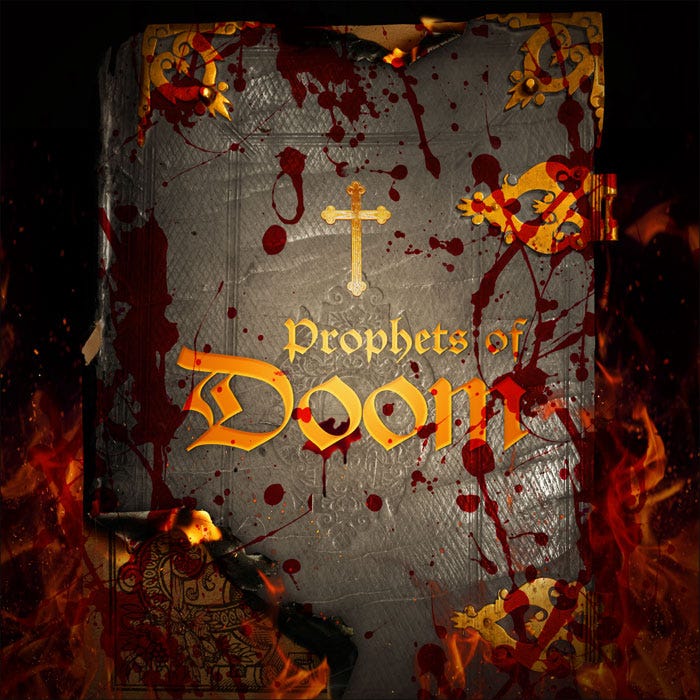Of Witches & iPods
On The Strange History of Ergot
Death and rebirth are central themes of Christianity, both in its mythology—the story of Jesus is about coming back from the dead—and in its actual history. Christianity resurrected dead and dying older traditions and carried them forward into the Middle Ages and beyond.
Three major examples—all readily allegorized by death and rebirth—are debt forgiveness, astronomical cycles, and ego death. These are the three main layers of Christian source material.
The experience of ego death feels precisely like a personal death and rebirth. That’s why existing religions in the Mediterranean Basin held god-eating ceremonies with psychedelic compounds like ergot to induce ego death, preceding the bread and the wine of the Christian Eucharist by thousands of years. The experience of ego death and rebirth found a perfect allegory in ancient stories of resurrected gods.
Ergot
Like winning numbers on a lotto scratch card, psychedelic drugs lurk just beneath the pages of history, waiting to be revealed by a scratch of the surface. Ergot, the magic-mushroom-like fungus that grows on cereal grains, is the quintessential example. It’s both highly hallucinogenic and highly toxic. Modern brewmasters routinely test for ergot, because the fungus is so poisonous and so commonly found on the cereal grains they use to brew their beer.
In 1938, a Swiss chemist named Albert Hoffmann used ergot to synthesize the first-ever batch of LSD. He separated the psychedelic effects of the ergot fungus from the agony it usually inflicted on those who ate it. Hoffmann couldn't possibly have comprehended the Pandora’s Box he opened.
In 2007, a very old Dr. Hoffman penned a letter to Steve Jobs. Jobs had been very vocal about crediting LSD for the creative inspiration that allowed him to revolutionize Apple Computer and bring the iPod to market. In light of its massive cultural impact on society, Dr. Hoffman hoped Jobs would fund more research into his remarkable chemical invention.
In another famous example, LSD massively impacted the trajectory of the Beatles. Their notorious LSD-fueled trip to India in 1968 delivered them from the poppy surf guitars of I Wanna Hold Your Hand into the revolutionary vision of The White Album and Sgt. Pepper’s Lonely Hearts Club Band. Under the guise of LSD, ergot has impacted modern society in ways that we are only just beginning to come to terms with.
The Salem Witch Trials
Ergot has also left its mark on other societies throughout history. In the fall of 1692, a late thaw caused moist conditions in the storehouses of Salem, Massachusetts. Unbeknownst to the town’s Puritan inhabitants, ergot fungus infested their grain. As the contaminated grain was consumed, some of the townspeople began to experience convulsions and strange visions.
The Puritans had no lens through which to understand these bizarre occurrences, except through the Christian faith that had driven them from the Old World to a dark new one. Recognizing what was—undoubtedly to them—the nefarious influence of the devil, they turned on one another. Twenty people lost their lives, and the tragic incident still haunts the public imagination to this day.
The Anabaptist Revolt of Münster
A century and a half before the Salem Witch Trials, in 1534, the people of Münster, Germany also unwittingly consumed grain contaminated with ergot. The city lapsed into sexual orgy and religious revelation. The ecstatic population rose up and expelled its dumbfounded Prince-Bishop, who was forced to return with an army and lay siege to his own city.
Once the dust had settled, the three main co-conspirators had their skin ripped off with hot tongs, and were hoisted in iron cages to the steeple of St. Lambert's Church. Though their bodies have long decayed, their cages hang there still, and the Anabaptist Revolt of Münster is remembered as an incident of some moment within the broader Protestant Reformation.
Ergotism
During the Middle Ages, the agonizing symptoms of ergot poisoning were known as “St. Anthony’s Fire”. Those who accidentally ingested ergot were rushed to the Hôpital Saint-Antoine in France. The monks there possessed secret remedies, passed down through the generations, that could ease the painful symptoms.
The Isenheim Altarpiece, painted by Matthias Grünewald for the monastery’s hospital, is famous for depicting Christ suffering from ergotism symptoms on the cross. His skin has a sickly green pallor, and his fingers are racked with painful convulsions. The title card for this essay shows the painting in question. The fascinating Isenheim Altarpiece is just one example of a longstanding Medieval association between Christ and psychoactive plants.
Ego Death
Whether consumed wittingly or unwittingly, ergot often invokes a religious experience because it promotes “ego death.”
The Ego is nothing more than the mental conception of oneself. If your body is your physical self, then the ego is the reflection of that body in the mirror of your consciousness. It’s your identity; it’s the sensation of being an individual. Unbelievably, introducing certain chemicals to the brain switches off this sensation. Just like nerves about approaching a beautiful woman at a bar can be switched off with a shot of liquid courage.
People feel religious when they experience ego death because it feels like death and rebirth of the self. After such a harrowing experience, people tend to identify as the human race in general rather than any specific instance of it. That’s why, for a thousand years, initiates of the Temple of Demeter at Eleusis whispered that drinking the secret ergot potion there granted them immortality. The trick to surviving your own death, they might have said, is simply to change how you define yourself.
Further Materials
Dan Carlin’s legendary podcast episode Prophets of Doom provides the best additional material for this essay. It describes the Anabaptist Revolt of 1534 in fantastic detail.





